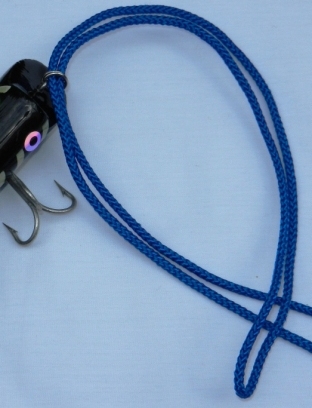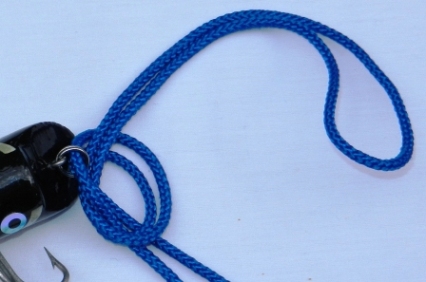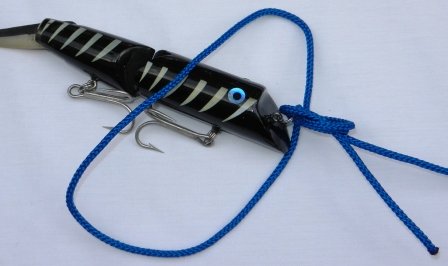Palomar Knot
The Palomar knot forms a knot with two lines passing through the eye or hook and is considered very secure. Learning to tie this knot will prepare you for situations when you are hoping a for a chance to catch a lunker. The steps are relatively few and easy to learn. This knot is considered one of the strongest knots for securing hooks and lures.
Tying the Knot - Step One
 Palomar Knot Step One
Palomar Knot Step One The first step in making this knot is to double up your fishing line back upon your working end. Pass the loop formed by this doubling through the eye or ring of your lure. Immediately you are able to see that you will have twice the security by having a double line passing through the eye. The end of the loop now becomes your working end.
Tying the Palomar Knot - Step Two
 Palomar Knot Step Two
Palomar Knot Step Two The next step in making the Palomard knot is to form an overhand knot with working end as in the picture above (formed using the looped line) There is really only one more important step so this overhand knot can be relatively tightened against the eye of your hook or lure. You should be left with a loop that is large enough to reach over your hook or lure. In my example I chose a large lure because of its large eye. The loop I began with and still have needs to be large enough to go over the large lure in the picture.
Tying the Palomar Knot Step Three
 Step Three
Step Three This third and final step is to pass this loop over the hook or lure. In the picture above is the beginning of this process and the picture below shows the loop passing back down along the lure body.
 Bring Loop Back to the Knot
Bring Loop Back to the Knot The only thing left to do is to tighten the knot and trim the extra loose line.
 Tighten Your Knot - Trim the Loose Line
Tighten Your Knot - Trim the Loose Line Fishing Knot Guides
We are an Amazon Affiliate. If you purchase a recommended product we stand to earn a small commission from qualifying purchases. If you click on one of our recommended products and purchase a different product from Amazon we may also receive a small commission. These products do not cost you any more than what is posted. Our staff recommends items that we have personally owned, tested, researched or we have fished with trusted anglers who recommend them.
These four resources come highly recommended. We at PFT each carry the freshwater knot guide in our tackle. Several of us use the knot tying tool on the right. I have a knot tying book like this one on my desk, but in addition have downloaded a knot tying app on my phone, which I use regularly.
Understanding Knot Terms
There are many terms used when describing tying fishing knots, marine knots, and other types of knots. Two words I will use in the descriptions of my favorite knots will be
- Standing End
- Working End
Understand the Working End
When beginning to learn to tie fishing knots, you will need to learn to leave enough extra line on your working end to finish the knot. With practice you will learn to estimate this very closely. As you progress through tying the knot you will quickly learn to tell if you will run out of line on your working end. Sometimes you will need to just start over because you will not have started with enough extra line on the working end to finish the knot. The rope used in these pictures is of course much bigger than fishing line - as a result the knots in these pictures are much bigger than you will make with your fishing line.. When done tying any knot trim any excess line on the working end so that it will not be in the way.